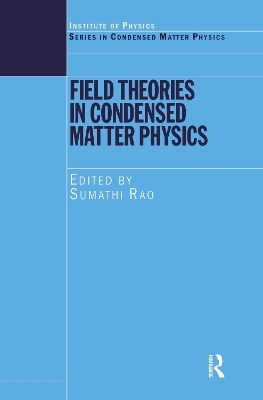
Field Theories in Condensed Matter Physics
Institute of Physics Publishing (Verlag)
978-0-7503-0876-2 (ISBN)
The application of field theoretic techniques to problems in condensed matter physics has generated an array of concepts and mathematical techniques to attack a range of problems such as the theory of quantum phase transitions, the quantum Hall effect, and quantum wires. While concepts such as the renormalization group, topology, and bosonization have become necessary tools for the condensed matter physicist, enough open problems and interesting applications remain to drive much activity in this area in the coming years.
Field Theories in Condensed Matter Physics presents a comprehensive survey of the concepts, techniques, and applications of the field. Written by experts and carefully edited, the book provides the necessary background for graduate students entering the area of modern condensed matter physics. It also supplies field theorists with a valuable introduction to the areas in condensed matter physics where field theoretic concepts can be fruitfully applied.
Sumathi Rao Barish-Chandra Research Institute Allahabad
Preface, Introduction, 1 Quantum Many Particle Physics, Pinaki Majumdar, 1.1 Preamble, 1.2 Introduction, 1.3 Introduction to many particle physics, 1.3.1 Phases of many particle systems, 1.3.2 Quantities of physical interest, 1.3.3 Fermi and Bose liquids, 1.4 Phase transitions and broken symmetry, 1.4.1 Phase transitions and symmetry breaking, 1.4.2 Symmetry breaking and interactions in BEC, 1.5 Normal Fermi systems: model problems, 1.5.1 Neutral fermions: dilute hardcore Fermi gas, 1.5.2 Charged fermions: the electron gas, 1.6 Electrons and phonons: Migdal-Eliashberg theory, 1.6.1 Weak coupling theory: BCS, 1.6.2 The normal state: Migdal theory, 1.6.3 BCS theory: Greens function approach, 1.6.4 Superconductivity: Eliashberg theory, 1.7 Conclusion: ‘field theory’ and many particle physics, 2 Critical Phenomena, Somendra M. Bhattacharjee, 2.1 Preamble, 2.1.1 Large system: Thermodynamic limit, 2.2 Where is the problem?, 2.3 Recapitulation - A few formal stuff, 2.3.1 Extensivity, 2.3.2 Convexity: Stability, 2.4 Consequences of divergence, 2.5 Generalized scaling, 2.5.1 One variable: Temperature, 2.5.2 Solidarity with thermodynamics, 2.5.3 More variables: Temperature and field, 2.5.4 On exponent relations, 2.6 Relevance, irrelevance and universality, 2.7 Digression, 2.7.1 A first-order transition: α=l, 2.7.2 Example: Polymers: no “ordering”, 2.8 Exponents and correlations, 2.8.1 Correlation function, 2.8.2 Relations among the exponents, 2.8.3 Length-scale dependent parameters, 2.9 Models as examples: Gaussian and ϕ4, 2.9.1 Specific heat for the Gaussian model, 2.9.2 Cut-off and anomalous dimensions, 2.9.3 Through correlations, 2.10 Epilogue, 3 Phase Transitions and Critical Phenomena, Deepak Kumar, 3.1 Introduction, 3.2 Thermodynamic stability, 3.3 Lattice gas: mean field approximation, 3.4 Landau theory, 3.5 Spatial correlations, 3.6 Breakdown of mean field theory, 3.7 Ginzburg-Landau free energy functional, 3.8 Renormalisation group (RG), 3.9 RG for a one dimensional Ising chain, 3.10 RG for a two-dimensional Ising model, 3.11 General features of RG, 3.11.1 Irrelevant variables, 3.12 RG scaling for correlation functions, 3.13 RG for Ginzburg-Landau model, 3.13.1 Tree-level approximation, 3.13.2 Critical exponents for d > 4, 3.13.3 Anomalous dimensions, 3.14 Perturbation series for d < 4, 3.15 Generalisation to a n-component model, 4 Topological Defects, Ajit M. Srivastava, 4.1 The subject of topological defect, 4.2 What is a topological defect?, 4.2.1 Meaning of order parameter, 4.2.2 Spontaneous symmetry breakdown(SSB), 4.2.3 SSB in particle physics, 4.2.4 Order parameter space, 4.3 The domain wall, 4.3.1 Why defect?, 4.3.2 Why topological?, 4.3.3 Energy considerations, 4.4 Examples of topological defects, 4.5 Condensed matter versus particle physics, 4.6 Detailed understanding of a topological defect, 4.6.1 Free homotopy of maps, 4.6.2 Based homotopy and the fundamental group, 4.7 Classification of defects using homotopy groups, 4.8 Defect structure in liquid crystals, 4.8.1 Defects in nematics, 4.8.2 Non abelian π1 - biaxial nematics, 4.9 Formation of topological defects, 5 Introduction to Bosonization, Sumathi Rao and Diptiman Sen, 5.1 Fermi and Luttinger liquids, 5.2 Bosonization, 5.2.1 Bosonization of a fermion with one chirality, 5.2.2 Bosonisation with two chiralities, 5.2.3 Field theory near the Fermi momenta, 5.3 Correlation functions and dimensions of operators, 5.4 RG analysis of perturbed models, 5.5 Applications of bosonization, 5.6 Quantum antiferromagnetic spin 1/2 chain, 5.7 Hubbard model, 5.8 Transport in a Luttinger liquid - clean wire, 5.9 Transport in the presence of isolated impurities, 5.10 Concluding remarks, 6 Quantum Hall Effect, R. Rajaraman, 6.1 Classical Hall effect, 6.2 Quantized Hall effect, 6.3 Landau problem, 6.4 Degeneracy counting, 6.5 Laughlin wavefunction, 6.6 Plasma analogy, 6.7 Quasi-holes and their Laughlin wavefunction, 6.8 Localization physics and the QH plateaux, 6.9 Chern-Simons theory, 6.10 Vortices in the CS field and quasiholes, 6.11 Jain’s theory of composite fermions, 7 Low-dimensional Quantum Spin Systems, Indrani Bose, 7.1 Introduction, 7.2 Ground and excited states, 7.3 Theorems and rigorous results for antiferromagnets, 7.3.1 Lieb-Mattis theorem, 7.3.2 Marshall’s sign rule, 7.3.3 Lieb, Schultz and Mattis theorem, 7.3.4 Mermin-Wagner theorem, 7.4 Possible ground states and excitation spectra, 7.5 The Bethe Ansatz
| Erscheint lt. Verlag | 30.5.2002 |
|---|---|
| Reihe/Serie | Condensed Matter Physics |
| Verlagsort | London |
| Sprache | englisch |
| Maße | 138 x 216 mm |
| Gewicht | 1200 g |
| Themenwelt | Naturwissenschaften ► Biologie |
| Naturwissenschaften ► Physik / Astronomie ► Festkörperphysik | |
| ISBN-10 | 0-7503-0876-1 / 0750308761 |
| ISBN-13 | 978-0-7503-0876-2 / 9780750308762 |
| Zustand | Neuware |
| Haben Sie eine Frage zum Produkt? |
aus dem Bereich


